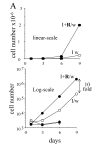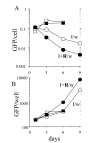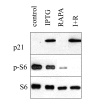Quantifying pharmacologic suppression of cellular senescence: prevention of cellular hypertrophy versus preservation of proliferative potential
- PMID: 20157583
- PMCID: PMC2815749
- DOI: 10.18632/aging.100115
Quantifying pharmacologic suppression of cellular senescence: prevention of cellular hypertrophy versus preservation of proliferative potential
Abstract
Development of agents that suppress aging (aging suppressants) requires quantification of cellular senescence. Cellular senescence in vitro is characterized by a large cell morphology and permanent loss of proliferative potential. When HT-1080 cells were arrested by p21, they continued to grow exponentially in size and became hypertrophic with a 15-fold increase in the protein content per cell. These changes were mirrored by accumulation of GFP (driven by CMV promoter) per cell, which also served as a marker of cellular hypertrophy. Preservation of proliferative potential (competence) was measured by an increase in live cell number, when p21 was switched off. While modestly decreasing hypertrophy in p21-arresrted cells, rapamycin considerably preserved competence, converting senescence into quiescence. Preservation of proliferative potential (competence) correlated with inhibition of S6 phosphorylation by rapamycin. When p21 was switched off, competent cells, by resuming proliferation, became progressively less hypertrophic. Preservation of proliferative potential is a sensitive and quantitative measure of suppression of mTOR-driven senescence.
Keywords: aging-suppression; cellular hypertrophy; cellular senescence; mTOR; rapamycin.
Conflict of interest statement
MVB is a founder of Oncotarget.
Figures












Similar articles
-
Rapamycin decelerates cellular senescence.Cell Cycle. 2009 Jun 15;8(12):1888-95. doi: 10.4161/cc.8.12.8606. Epub 2009 Jun 1. Cell Cycle. 2009. PMID: 19471117
-
Rapamycin, proliferation and geroconversion to senescence.Cell Cycle. 2018;17(24):2655-2665. doi: 10.1080/15384101.2018.1554781. Epub 2018 Dec 12. Cell Cycle. 2018. PMID: 30541374 Free PMC article.
-
Growth stimulation leads to cellular senescence when the cell cycle is blocked.Cell Cycle. 2008 Nov 1;7(21):3355-61. doi: 10.4161/cc.7.21.6919. Epub 2008 Nov 12. Cell Cycle. 2008. PMID: 18948731
-
Aging and immortality: quasi-programmed senescence and its pharmacologic inhibition.Cell Cycle. 2006 Sep;5(18):2087-102. doi: 10.4161/cc.5.18.3288. Epub 2006 Sep 15. Cell Cycle. 2006. PMID: 17012837 Review.
-
Cell senescence, rapamycin and hyperfunction theory of aging.Cell Cycle. 2022 Jul;21(14):1456-1467. doi: 10.1080/15384101.2022.2054636. Epub 2022 Mar 31. Cell Cycle. 2022. PMID: 35358003 Free PMC article. Review.
Cited by
-
Inhibition of S6K by resveratrol: in search of the purpose.Aging (Albany NY). 2009 Jun 29;1(6):511-4. doi: 10.18632/aging.100059. Aging (Albany NY). 2009. PMID: 20157534 Free PMC article. No abstract available.
-
Hyper-mitogenic drive coexists with mitotic incompetence in senescent cells.Cell Cycle. 2012 Dec 15;11(24):4642-9. doi: 10.4161/cc.22937. Epub 2012 Nov 27. Cell Cycle. 2012. PMID: 23187803 Free PMC article.
-
The lifespan extension effects of resveratrol are conserved in the honey bee and may be driven by a mechanism related to caloric restriction.Aging (Albany NY). 2012 Jul;4(7):499-508. doi: 10.18632/aging.100474. Aging (Albany NY). 2012. PMID: 22868943 Free PMC article.
-
Yeast-like chronological senescence in mammalian cells: phenomenon, mechanism and pharmacological suppression.Aging (Albany NY). 2011 Nov;3(11):1078-91. doi: 10.18632/aging.100402. Aging (Albany NY). 2011. PMID: 22156391 Free PMC article.
-
Transcriptional profiling of interleukin-2-primed human adipose derived mesenchymal stem cells revealed dramatic changes in stem cells response imposed by replicative senescence.Oncotarget. 2015 Jul 20;6(20):17938-57. doi: 10.18632/oncotarget.4852. Oncotarget. 2015. PMID: 26255627 Free PMC article.
References
-
- Serrano M, Blasco MA. Putting the stress on senescence. Curr Opin Cell Biol. 2001;13:748–53. - PubMed
-
- Shay JW, Roninson IB. Hallmarks of senescence in carcinogenesis and cancer therapy. Oncogene. 2004;23:2919–2933. - PubMed
-
- Ruggero D, Montanaro L, Ma L, Xu W, Londei P, Cordon-Cardo C, Pandolfi PP. The translation factor eIF-4E promotes tumor formation and cooperates with c-Myc in lymphomagenesis. Nat Med. 2004;10:484–486. - PubMed
-
- Efeyan A, Ortega-Molina A, Velasco-Miguel S, Herranz D, Vassilev LT, Serrano M. Induction of p53-dependent senescence by the MDM2 antagonist nutlin-3a in mouse cells of fibroblast origin. Cancer Res. 2007;67:7350–7357. - PubMed
MeSH terms
Substances
LinkOut - more resources
Full Text Sources
Other Literature Sources
Medical
Miscellaneous
